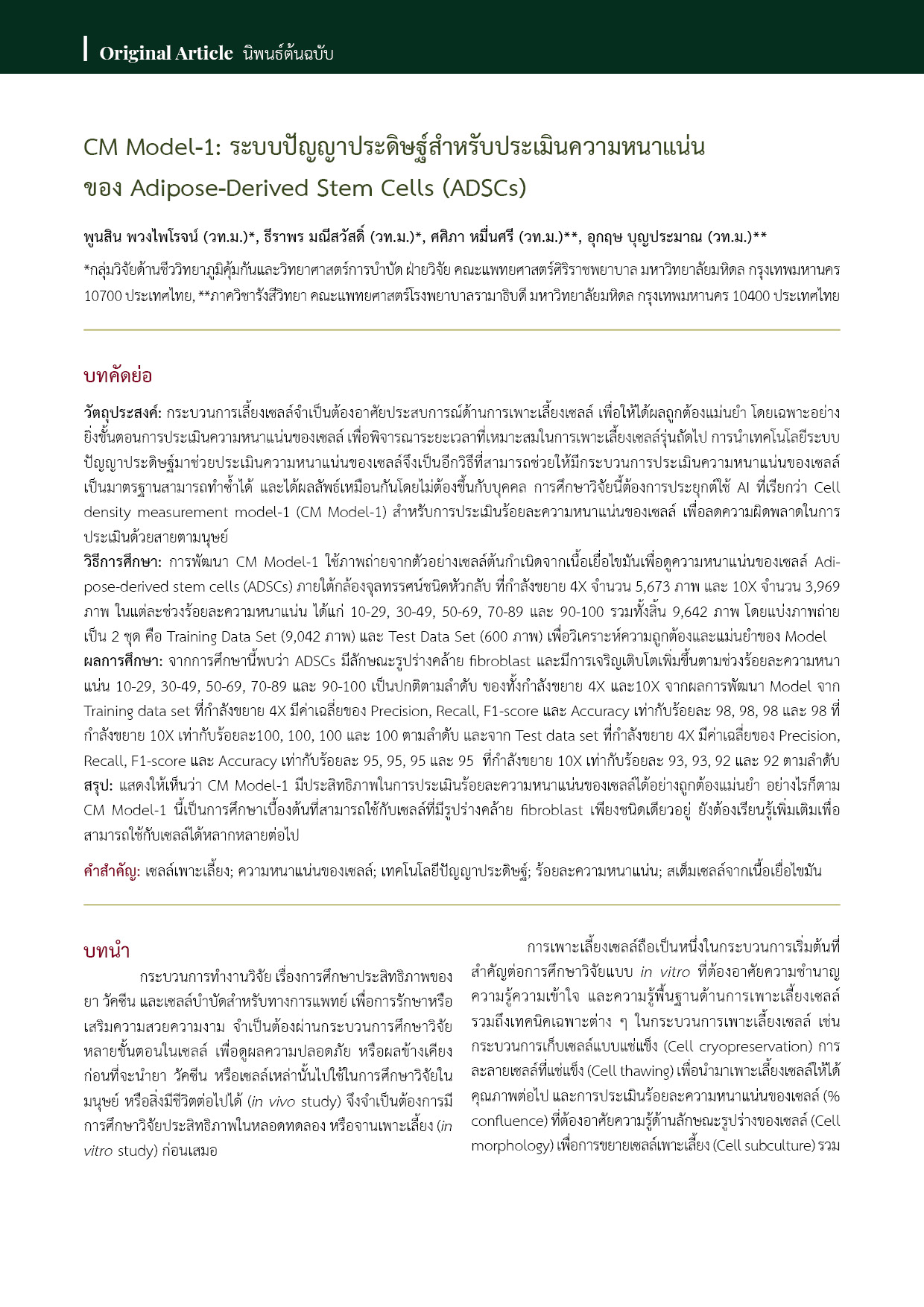CM Model-1: An Artificial Intelligence for Measuring Density of Adipose-Derived Stem Cells (ADSCs)
Main Article Content
Abstract
Objective: The cell culture process requires an experienced person to evaluate the cell density so that results can be accurate and precise. To reduce human errors, artificial intelligence (AI) technology is implemented for cell density estimation. This will create the standardization of the assessment and improve repeatability, and reproductivity without human concerns. This study thus aims to apply an AI system (cell density measurement model-1, CM Model-1) for percent confluence evaluation to replace human visual judgement.
Material and Methods: The CM Model-1 was developed by using 9,642 images consisting of training data (9,042 images) and test data sets (600 images) at different % confluence (i.e., 10-29%, 30-49%, 50-69%, 70-89%, and 90-100%) of adipose-derived stem cells (ADSCs) during the serial passaging. Cell morphology and numbers were observed by using an inverted microscope at 4X (5,673 images) and 10X (3,969 images) magnification.
Results: The morphology of ADSCs was fibroblast-liked cells and had a normal growth rate. Results show that the training data set from the CM Model-1 had average precision, recall, F1-score and accuracy values at 4X magnification of 98% for all values and those at 10X magnification were 100% for all values. However, the results from the test data set at 4X magnification had lower with 95% for all those and at 10X magnification were 93% for precision, 93% for recall, 92% for F1-score, and 92% for accuracy.
Conclusion: The CM Model-1 is reliable with great precision, accuracy and reproducibility. Nevertheless, CM Model-1 was performed with only fibroblast-like cells in the preliminary study; therefore, it is warranted to further explore in different cell types.
Article Details

This work is licensed under a Creative Commons Attribution-NonCommercial-NoDerivatives 4.0 International License.
References
Weiskirchen S, Schröder SK, Buhl EM, Weiskirchen R. A Beginner's Guide to Cell Culture: Practical Advice for Preventing Needless Problems. Cells. 2023 21;12(5):682. doi: 10.3390/cells12050682.
Ian Freshney R. Basic principle of cell culture. In: Vunjak-Norakovic G, Ian Freshney R, editors. Culture of cells for tissue engineering. New Jersey: John Wiley & Son; 2006. p. 3-22.
Korzyńska A, Zychowicz M. A method of estimation of the cell doubling time on basis of the cell culture monitoring data. Biocybern Biomed Eng 2008;28(4):75-82.
Shende P, Devlekar NP. A review on the role of artificial intelligence in stem cell therapy: an initiative for modern medicines. Curr Pharm Biotechnol. 2021;22(9):1156-63.
Amisha, Malik P, Pathania M, Rathaur VK. Overview of artificial intelligence in medicine. J Family Med Prim Care. 2019;8(7):2328-31.
Joutsijoki H, Haponen M, Rasku J, Aalto-Setälä K, Juhola M. Machine learning approach to automated quality identification of human induced pluripotent stem cell colony images. Comput Math Methods Med. 2016. doi: 10.1155/2016/3091039.
Zhu M, Heydarkhan-Hagvall S, Hedrick M, Benhaim P, Zuk P. Manual isolation of adipose-derived stem cells from human lipoaspirates. J Vis Exp. 2013. doi: 10.3791/50585.
Aronowitz JA, Lockhart RA, Hakakian CS. Mechanical versus enzymatic isolation of stromal vascular fraction cells from adipose tissue. Springerplus. 2015;4:713. doi: 10.1186/s40064-015-1509-2.
Senesi L, De Francesco F, Farinelli L, Manzotti S, Gagliardi G, Papalia GF, Riccio M, Gigante A. Mechanical and enzymatic procedures to isolate the stromal vascular fraction from adipose tissue: preliminary results. Front Cell Dev Biol. 2019;7:88. doi: 10.3389/fcell.2019.00088.
Doornaert M, De Maere E, Colle J, Declercq H, Taminau J, Lemeire K, Berx G, Blondeel P. Xenogen-free isolation and culture of human adipose mesenchymal stem cells. Stem Cell Res. 2019;40:101532. doi: 10.1016/j.scr.2019.101532.
Winnier GE, Valenzuela N, Peters-Hall J, Kellner J, Alt C, Alt EU. Isolation of adipose tissue derived regenerative cells from human subcutaneous tissue with or without the use of an enzymatic reagent. PLoS One. 2019;14(9):e0221457. doi: 10.1371/journal.pone.0221457.
Chang H, Do BR, Che JH, Kang BC, Kim JH, Kwon E, et al. Safety of adipose-derived stem cells and collagenase in fat tissue preparation. Aesthetic Plast Surg. 2013;37(4):802-8.
Lee SJ, Lee CR, Kim KJ, Ryu YH, Kim E, Han YN, et al. optimal condition of isolation from an adipose tissue-derived stromal vascular fraction for the development of automated systems. Tissue Eng Regen Med. 2020;17(2):203-8.
Duan W, Lopez MJ. Effects of enzyme and cryoprotectant concentrations on yield of equine adipose-derived multipotent stromal cells. Am J Vet Res. 2018;79(10):1100-12.
Thitilertdecha P, Lohsiriwat V, Poungpairoj P, Tantithavorn V, Onlamoon N. Extensive Characterization of Mesenchymal Stem Cell Marker Expression on Freshly Isolated and In Vitro Expanded Human Adipose-Derived Stem Cells from Breast Cancer Patients. Stem Cells Int. 2020. doi: 10.1155/2020/8237197.
Zhang J, Liu Y, Chen Y, Yuan L, Liu H, Wang J, Liu Q, Zhang Y. Adipose-derived stem cells: current applications and future directions in the regeneration of multiple tissues. Stem Cells Int. 2020. doi: 10.1155/2020/8810813.
Tang H, He Y, Liang Z, Li J, Dong Z, Liao Y. The therapeutic effect of adipose-derived stem cells on soft tissue injury after radiotherapy and their value for breast reconstruction. Stem Cell Res Ther. 2022. doi: 10.1186/s13287-022-02952-7.
Lopa S, Colombini A, Moretti M, de Girolamo L. Injective mesenchymal stem cell-based treatments for knee osteoarthritis: from mechanisms of action to current clinical evidences. Knee Surg Sports Traumatol Arthrosc. 2019;27(6):2003-20.
Kulkarni A, D Chong, Batarseh FA. 5 - Foundations of data imbalance and solutions for a data democracy. In: Batarseh FA, Yang R, editors. Data Democracy: At the nexus of artificial intelligence, software development, and knowledge engineering. United Kingdom: Elsevier Science; 2020. p.83-106.
Topman G, Sharabani-Yosef O, Gefen A. A method for quick, low-cost automated confluency measurements. Microsc Microanal. 2011;17(6):915-22.
Chiu C-H, Leu J-D, Lin T-T, Su P-H, Li W-C, Lee Y-J, et al. Systematic quantification of cell confluence in human normal oral fibroblasts. Applied Sciences 2020;10(24):9146. doi:org/10.3390/app10249146






